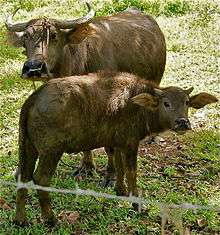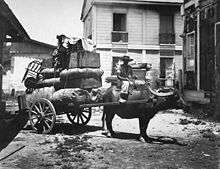Carabao
 A carabao in the Philippines | |
| Country of origin | Philippines |
|---|---|
| Distribution | Philippines, Guam |
| Type | Swamp |
| Use | Agriculture; draught; riding; hide; meat |
| Traits | |
| Weight | Male: 420–500 kg |
| Female: 400–425 kg | |
| Height | Male: 127–137 cm |
| Female: 124–129 cm | |
| Coat | light grey to slate-grey |
|
Water buffalo Bubalus bubalis | |
The carabao is a swamp-type domestic water buffalo (Bubalus bubalis) found in the Philippines.[1] Water buffaloes were probably introduced to the Philippines by Malay immigrants around 300 to 200 BCE. It is considered the national animal of the Philippines.[2]
Etymology
The word carabao is from Spanish, derived from Visayan karabàw.[3] Cognates include Tagalog kalabáw, Javanese kebo, Malay kerbau, and Indonesian Dutch karbouw. The ultimate origin of the word is an unidentified Austroasiatic language via Malay. The female is called a caraballa.[4]
The Minangkabau people of Indonesia take their name from the cognate in their Malayic language, the Minangkabau language.
Characteristics

Carabaos have the low, wide, and heavy build of draught animals. They vary in colour from light grey to slate grey. The horns are sickle-shaped or curve backward toward the neck. Chevrons are common. Albinoids are present in the proportion of about 3% of the buffalo population. Mature male carabaos weigh 420–500 kg (930–1,100 lb), and females 400–425 kg (882–937 lb). Height at withers of the male ranges from 127–137 cm (50–54 in), and of the female from 124–129 cm (49–51 in).
Water buffaloes imported to the Philippines from Cambodia in the early 20th century are called "Cambodian carabaos". They have white or yellowish hair on a pinkish skin, but the eyes, hooves, and mouth are dark, and the skin may be speckled. They are slightly bigger and have larger horns. Males weigh on average 673 kg (1,484 lb) and measure 141 cm (56 in) at the withers.[4]
Husbandry
Water buffaloes are well adapted to a hot and humid climate. Water availability is of high importance in hot climates since they need wallows, rivers, or splashing water to reduce the heat load and thermal stress.[5] Swamp buffaloes prefer to wallow in a mudhole that they make with the horns. Their objective is to acquire a thick coating of mud. They thrive on many aquatic plants and in time of flood will graze submerged, raising their heads above the water and carrying quantities of edible plants. They eat reeds, the giant reed, bulrush, sedges, the common water hyacinth, and rushes. Green fodders are used widely for intensive milk production and for fattening. Many fodder crops are conserved as hay, chaffed, or pulped. Trials in the Philippines showed that the carabao, on poor-quality roughage, had a better feed conversion rate than cattle.[4]
The carabao cools itself by lying in a waterhole or mud during the heat of the day. Mud, caked on to its body, also protects it from bothersome insects. The carabao feeds mainly in the cool of the mornings and evenings. Its lifespan is 18 to 20 years and the female carabao can deliver one calf each year.
In the Philippines
Malay immigrants probably introduced water buffaloes in the period 300 to 200 BC. Later Chinese settlers also brought water buffaloes that are sometimes referred to as "Shanghai buffaloes". Carabaos are widely distributed in all the larger islands of the Philippines. Early in the 20th century, water buffaloes were imported from Cambodia for work in sugarcane plantations; Cambodian carabaos are larger and have bigger horns. Murrah buffaloes were first introduced from India in 1917. A few representatives of the Niliravi breed have also been acquired. The word carabao is now used for the imported river type buffaloes, as well as for the local swamp buffaloes.[4]
Carabao hide was once used extensively to create a variety of products, including the armor of precolonial Filipino warriors.
In 1993, the Philippine Carabao Center was established to conserve, propagate, and promote the carabao as a source of draft animal power, meat, milk, and hide to benefit the rural farmers through carabao genetic improvement, technology development and dissemination, and establishment of carabao-based enterprises, thus ensuring higher income and better nutrition. The National Water Buffalo Gene Pool in the Muñoz, Nueva Ecija, is a facility for continuous selection, testing, and propagation of superior breeds of dairy buffaloes.[6]

In 2003, 3.2 million carabao were in the Philippines; 99% belonged to small farmers who have limited resources, low income, and little access to other economic opportunities.[5]
One of the many reasons for the failure of the attempted Japanese pacification of the Philippines during their 1941-1945 occupation was their indifference to the basics of the Filipino economy. The carabaos provided the necessary labor that allowed Filipino farmers to grow rice and other staples. Japanese army patrols would not only confiscate the rice, but would also slaughter the carabaos for meat, thereby preventing the farmers from growing enough rice to feed the large population. Before World War II, an estimated three million carabaos inhabited the Philippines. By the end of the war, an estimated nearly 70% of them had been lost.[7]
The old payatak method of farming is still the method of choice in Northern Samar. The soil of the rice paddy is first softened with rainwater or diverted watershed, then the farmer guides a group of carabaos in trampling the planting area until it is soggy enough to receive the rice seedlings. This time-consuming task produces lower yields and lower income when compared with the advancement in irrigated fields.[8] In the late 1980s, the carabao puppet character Kardong Kalabaw became popular as a symbol of the Filipino people's hard work and sense of industry.[9]

Carabao racing
Carabao racing is a widely popular sport among farmers and carabao enthusiasts in the Philippines. In central and southern Luzon some feast is highlighted with carabaos racing up towards the finish line. Training and conditioning of the race carabao to its full extent is a serious job. Farmers and their trustworthy carabaos gather together to race in a 500 metres (1,600 ft) dirt road. Spectators fill up this unique spectacle, some betting on their best carabaos, others watch for the thrill. The carabaos, geared with their carts on their back, race together with their dear farmer to win prizes. The race is divided into two classes, one for amateur or first time carabao racers and the other is for the veteran carabao racers. A race carabao can be bought for P35,000 to P60,000, with the price increasing with the number of races that it wins. Proven race winners can command a price as high as P200,000. The race is divided into two classes, one for amateur or first time carabao racers and the other is for the veteran carabao racers.
In Guam
Carabaos were introduced to Guam by Spanish missionaries in the 17th century from domestic stock in the Philippines to be used as beasts of burden. A feral herd on the US Naval Magazine in central Guam was classified as protected game, but the population has been declining since 1982, most likely due to illegal hunting.[10]
Carabaos were used for farming and for pulling carts. They were fairly common in Guam before the 20th century, with a population numbering in the thousands. Today, they are rare in most parts of the island except in the US Naval Magazine near the village of Santa Rita, which is fenced on all sides. The carabao population of Naval Magazine has grown to several hundred, to the point that they have become a pest and caused environmental damage, and polluted the water supply in the Fena Reservoir. In 2003, the Navy began a program of extermination to control the carabao population of Naval Magazine, a move that was protested by many Chamorro people.
The carabao is considered a symbol of Guam. In the early 1960s, carabao races were a popular sport in the island, especially during fiestas. Today, carabaos are a part of the popular culture. They are often brought to carnivals or other festivities, and are used as a popular ride for children. Carabao meat is sometimes eaten as a delicacy.
In Malaysia
The carabao is the official animal of the state of Negeri Sembilan, Malaysia.[11]
See also
References
- ↑ FAO 2013. Philippine Carabao/Philippines In: Domestic Animal Diversity Information System. Food and Agriculture Organization of the United Nations, Rome.
- ↑ Aquino, Dante M.; Persoon, Gerald A. (2013). "Tradition and Change: Beer Consumption in Northeast Luzon, Philippines". In Schiefenhovel, Wulf; Macbeth, Helen. Liquid Bread: Beer and Brewing in Cross-Cultural Perspective. Volume 7 of Anthropology of Food & Nutrition. Berghahn Books. p. 197. ISBN 9781782380344. Retrieved 20 August 2014.
- ↑ Roberts, E. A. (2014). A Comprehensive Etymological Dictionary of the Spanish Language with Families of Words based on Indo-European Roots. Volume I (A–G). Xlibris LLC. p. 311. ISBN 9781493191109.
- 1 2 3 4 Cockrill, W. R., ed. (1977). The Water Bufallo (PDF). Animal Production and Health Series No. 4. Food and Agriculture Organization of the United Nations. ISBN 9251001081.
- 1 2 Borghese, A., Mazzi, M. (2005). Buffalo Population and Strategies in the World. Pages 1–39 in Borghese, A. (ed.) Buffalo Production and Research. REU Technical Series 67. Inter-regional Cooperative Research Network on Buffalo, FAO Regional Office for Europe, Rome.
- ↑ Philippine Carabao Center (2011). Annual Report. Department of Agriculture.
- ↑ Schmidt, L. S. (1982). American Involvement in the Filipino Resistance on Mindanao During the Japanese Occupation, 1942-1945. M.S. Thesis. U.S. Army Command and General Staff College.
- ↑ Philippine Daily Inquirer, 8-18-2007. Archived October 28, 2007, at the Wayback Machine.
- ↑ Alfie Vera Mella, May Natutunan Ka Ba kay Kiko Matsing?, The Filipino Journal, archived from the original on 2009-02-11, retrieved 2007-12-18
- ↑ Conry, P. J. (1988). Management of feral and exotic game species on Guam. Transactions of the Western Section of the Wildlife Society 24: 26–30.
- ↑ (Malay) "Archived copy". Archived from the original on 2008-03-13. Retrieved 2008-03-09.
| Wikimedia Commons has media related to Carabao. |